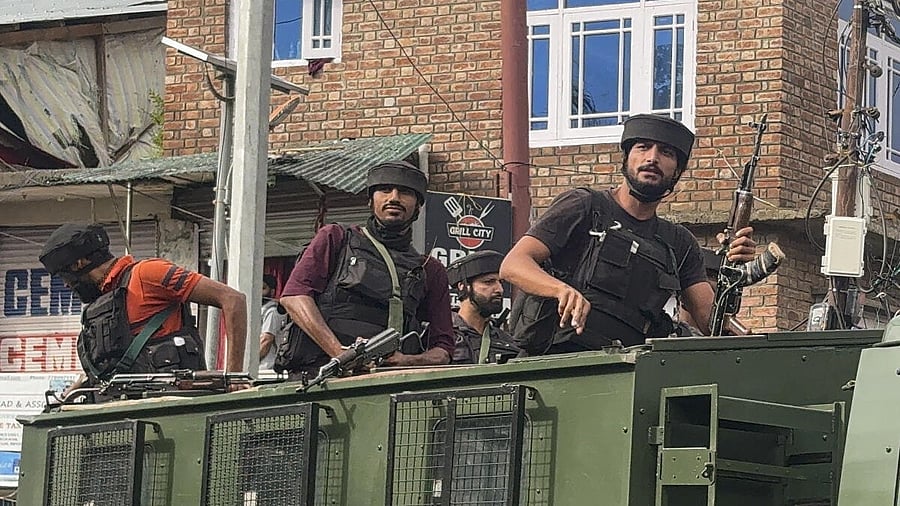
Security personnel on the sixth day of anti-terrorist operation, in Jammu and Kashmir's Kulgam.
Credit: PTI Photo
Srinagar: The prolonged encounter between terrorists and security forces in the dense forests of south Kashmir’s Kulgam district, now stretching into its eighth day, has once again triggered alarm bells within the security establishment, hinting at a significant shift in militant tactics in the Union Territory.
Officials said two terrorists have been killed so far in the ongoing operation that began on August 1 in the Akhal forest area, following specific intelligence inputs. At least seven security personnel have been injured in the intense gun battle that has played out in the rugged and heavily forested terrain.
The anti-terror operation, one of the longest in recent memory in the valley, has seen the deployment of high-tech surveillance tools, including drones and helicopters. Para commandos have also been pressed into service to assist in flushing out the remaining terrorists believed to be hiding deep inside the forest.
The drawn-out nature of the Kulgam gunfight has added to concerns already raised by a series of similar encounters in the forested belts of Jammu’s Kathua, Doda, Reasi, Rajouri, and Poonch districts.
These areas have witnessed a noticeable spike in militant activity in recent years, pointing to a possible strategic shift: that terrorists, including battle-hardened infiltrators from across the border, are choosing to entrench themselves in treacherous jungle terrain to wage a long-drawn guerrilla war.
Security experts say this change in operational dynamics is deliberate and calculated.
“Guerrilla-trained terrorists are now striking with high surprise in forested mountains at short intervals,” a senior security official told DH. “It’s harder to track them in such terrain, and operations in dense forests are always high-risk and time-consuming.”
Political analyst Zafar Choudhary believes the resurgence of forest-based violence is symbolic. “The violence post-2019 — after the abrogation of Article 370 — appears to be a well-thought-out strategy by militant groups to signal that the conflict has not ended, despite New Delhi’s constitutional changes,” he said.
“Since the security forces have achieved significant success in neutralising terrorism in the Valley over the past few years, the militants have now shifted the battlefront to the mountains,” Choudhary added. “These attacks are clear evidence that terrorism in Kashmir is far from over, as claimed by the Modi government.”
Intelligence sources and security observers also believe the re-emergence of forest warfare is linked to broader geopolitical objectives, especially from across the Line of Control (LoC).
According to officials, Pakistan-based handlers are attempting to reassert the Kashmir narrative, which has been largely weakened in recent years. With traditional overground worker (OGW) networks disrupted and urban surveillance tightened, dense forests offer a tactical sanctuary — allowing small groups of trained terrorists to regroup, launch surprise attacks, and survive longer.
“The forested terrain gives infiltrated terrorists both cover and the element of surprise. These recent attacks are not isolated incidents but part of a larger game plan to sustain militancy in a new form,” said a former military intelligence officer, who has served in the region.
While the government continues to assert that normalcy has returned to Jammu and Kashmir post-Article 370 abrogation, the recent Kulgam encounter — along with the spike in attacks in Jammu’s mountainous districts — has exposed the resilience of militant groups and the evolving nature of the threat.